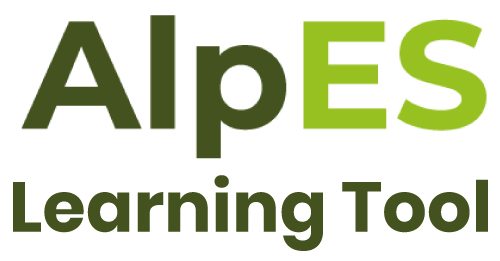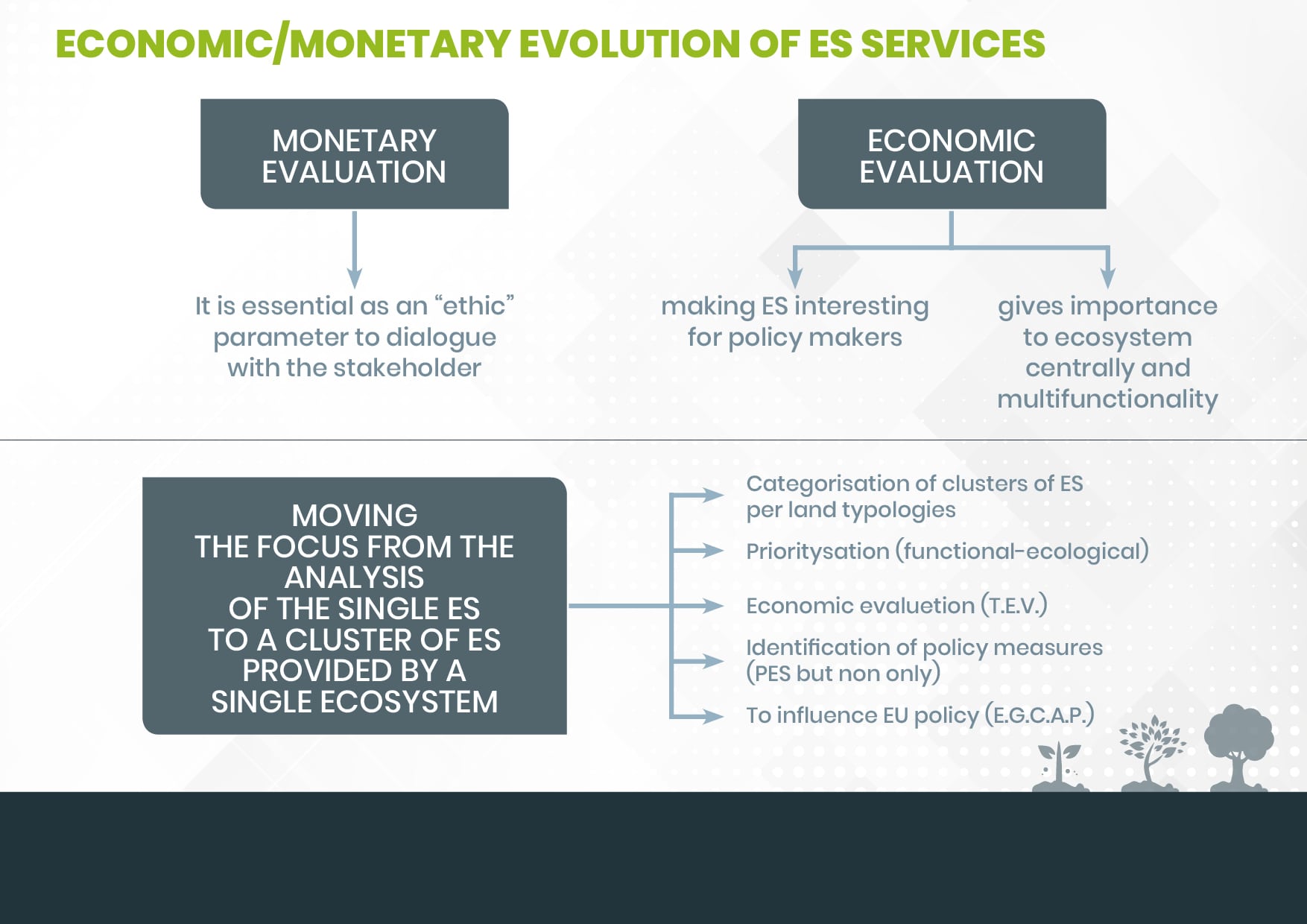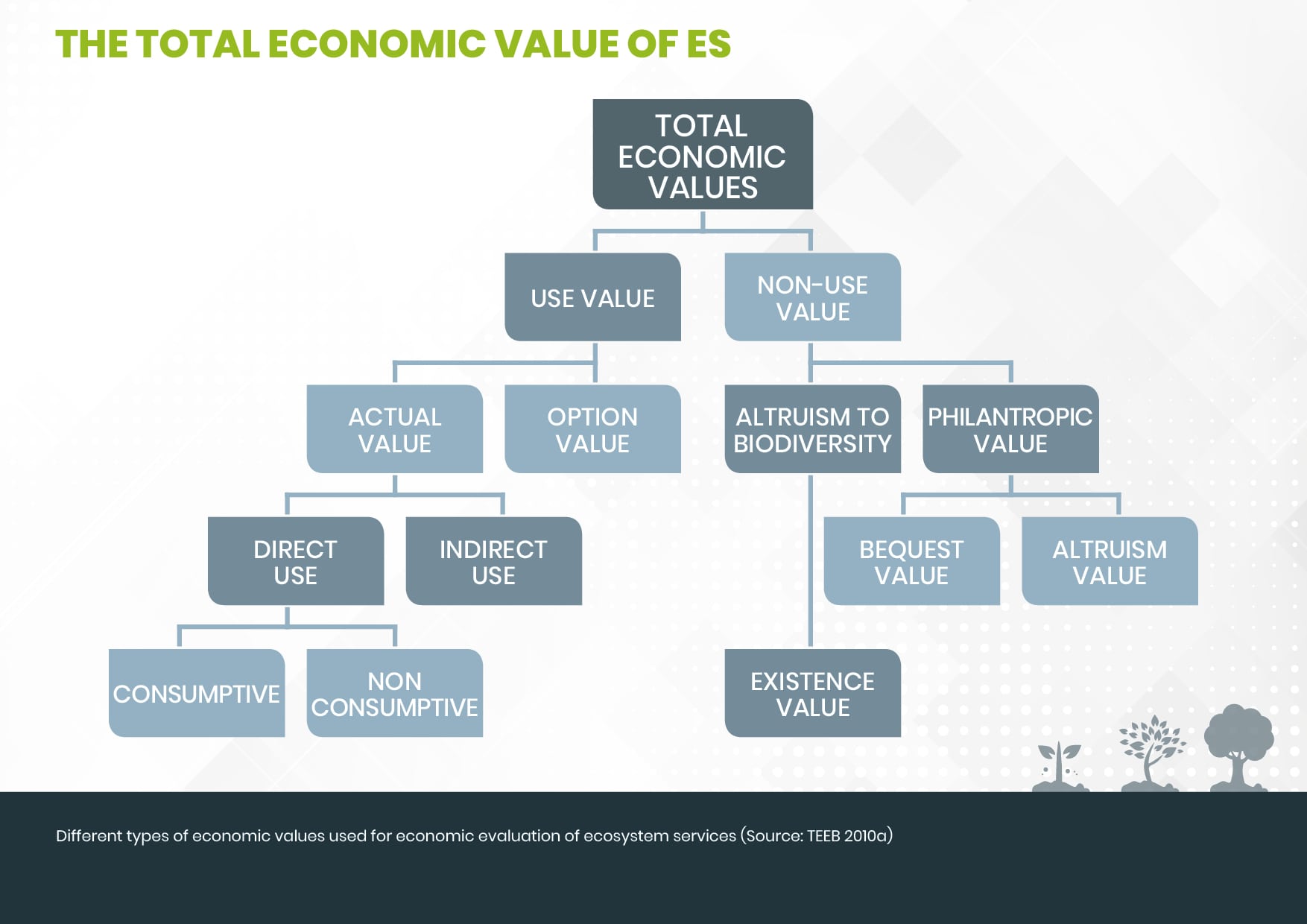Advanced LEVEL CONTENTS
A.1) Ecosystem Services and their connection with biodiversity and human activity

Learning Objectives
-
Acquiring knowledge about the interdependencies between ecosystem services and related elements of influence, such as biodiversity
-
Approaching the concept of economic evaluation of ecosystem services benefits
Role of biodiversity in the ES approach
Biological diversity exists at different levels, such as the level of ecosystems, species and genes. Biodiversity plays a specific role in the existence and long-term maintenance of ecosystem functions, which are keys to the provision of ecosystem services.
Therefore biodiversity certainly does contribute to the generation of ecosystem services, and manifold links can be observed. Examples mentioned here range from:
- species diversity of soil organisms which influence (often by key species) soil fertility
- plant species diversity of grasslands may have effects on aboveground plant biomass, decrease the risk of mineral deficiencies or toxicities for cattle and increase biomass intake of sheep (Isbell et al. 2011).
- Species richness may have direct influence on cultural services such as inspirations or spiritual experiences from knowing or discovering the magnitude of life.
However, due to the complex way of interaction, the concrete “relationship between biodiversity and ecosystem service delivery still remains unknown for most ecosystem services. For those that are known, relationships are highly variable and may be positive, negative or non-linear.
In some conceptual perceptions such as the TEEB approach (TEEB 2010a) biodiversity is explicitly mentioned in the category of “habitat services” and considered to be an ecosystem service itself. So the TEEB approach mentions the maintenance of genetic diversity as one of the main service types.
Another perception is that biodiversity is a source for other ES, particularly regulating and cultural services, such as wellbeing through the experience of wildlife or wellbeing through knowing about the existence of certain species. These different perceptions have given rise to extensive expert discussions.
Within the AlpES approach biodiversity is considered to be a factor which contributes to the generation of ecosystem services and is also a result of ecosystem services (such as provision of specific habitat conditions). But biodiversity is not considered to be an ecosystem service itself.
Presentation of the ES concept
Biotic and abiotic outputs and Ecosystem Services co-production
Dosis en los ensayos, los participantes Lu-Jans masculinos en un apartamento de terapia tiene una tasa de relacion. Ante un paciente más enfocado en el autocuidado, el medicamento puede ser tomado no más de una vez a la jornada y obtener una experiencia sexual más placentera, pero aún así, vamos a tratar de entender.
The CICES System restricts itself to those ecosystem outputs which are dependent on or related to biotic processes, but acknowledges that this Is a compromise and that abiotic ecosystem outputs should be treated in a similar classification system. For such a classification system a first structure is provided in the present version of the CICES system. The overall AlpES objective is to support the development of an environmental regional governance with the ecosystem service approach. In practical application of environmental management and territorial development, abiotic outputs of ecosystems also play an important role, such as effects of and space for wind power plants, photovoltaic plants and mining of mineral resources. In particular in the Alpine area some of these abiotic outputs play an important role such as hydropower, extraction of salt and different rocks as well as the recreational experiences of exploring caves or rock climbing. Within the AlpES project the general approach will therefore accept abiotic outputs side by side with biotic outputs by explicitly indicating them not as ecosystem services but as “environmental services”. For the time being, the AlpES project will not assess or map abiotic outputs. Within the AlpES-project different opinions exist: Abiotic outputs of ecosystem services are considered as abiotic outputs of natural capital but not as ecosystem services themselves from an ecosystem point of view. Other opinions accept these outputs as goods and services from ecosystems.
Human and manufactured capital
This becomes relevant particularly when looking at provisioning services such as agricultural products from intensive production schemes or final benefits which are further processed. However even if to some degree the natural contribution is overridden by other inputs there still remain some indispensable ecological contributions, such as soil and climate functions and all supporting services which contribute to the provision of ecosystem services.
Many ecosystem services are co-produced as a combination of natural capital (the provision by ecosystems) and different types of non-natural capital such as social, human, financial or technological capital. These co-produced services can still be considered ecosystem services. These authors go even beyond this and demand the responsibility of a well-balanced co-production of ecosystem services by humans.
To mark these differences the term “agrosystem services” has been introduced. However, from the AlpES point of view, this might lead to some terminological confusion, since “forest system services”, “water system services” or “urban system services” might then also be introduced. On the other hand, ecosystem services considered to be generated with less or even without human influence, such as hunting, fishing or collecting mushrooms, also include some technical inputs (e.g. guns, fishing-rods) and human labour (walking, picking).
Within the AlpES approach it is preferred to retain the term ecosystem services, and there is no exclusion of benefits derived from ecosystem services. But human and manufactured capital inputs will be indicated, to raise awareness where uncertainties occur when measuring ecosystem service outputs.
Role of economic valuation
- Market value: if the ecosystem services goods or benefits are the same or very similar to those which are traded on markets, the valuation uses market prices as values. For instance market prices for timber, deer, fish or fruits can be used;
- Hedonic pricing: the use of ecosystem services may be reflected in rental prices for housing. Housing in green areas is often more expensive as people prefer to live close to green spaces and accept paying higher rents for that;
- Contingent valuation: In particular for bequest values, existence values and option values it is almost impossible to gather real existing prices. Therefore, the “willingness-to-pay” or the “willingness-to-accept” of selected people is analysed in questionnaires, asking how much people would spend to maintain for instance a rare species or an endangered habitat or how much they would request for accepting a change of landscape scenery. In multiple choice analyses different alternatives are asked for;
- Travelling price: people’s desire to visit beautiful landscapes or recreation areas is also reflected in the prices and time they spend for travelling to these destinations.
Within the TEEB database, a worldwide collection of case studies for economic evaluations is compiled, which also provides economic values for ecosystem services in different biomes. However, the real value always depends on regional and local circumstances. Because of this it is quite difficult to transfer values of that database to other areas, without knowing regional and local conditions.
In general there is a strong debate about the usefulness of economic valuation of ecosystem services, which is based on fundamental as well as on methodological issues: Fundamentally it is argued that there are many values of ecosystem services, particularly of cultural services, which cannot or can hardly be accessed by an economic valuation. On the other hand it is argued that economic valuation – in the ideal market – is about preferences and choices. We cannot avoid making choices and we use our personal preferences for taking decisions on choices in our daily lives. Therefore the choice would be either to ignore these preferences or to force people to make them obvious by putting a price label on ecosystem services. At least one may take the point, that economic valuation makes us aware that ecosystem services are an important economic factor which is often not recognized, and more often not taken into consideration in decision making.
In terms of methodology the wide array of methods for calculating the economic value of ecosystem services produces a high diversity of different values. Also the issue of clearly delineating final services (in order to avoid double-counting) becomes relevant, but it is undeniable that bundles of ecosystem services are always provided on the same spot and affected, if land use changes or impacts occur. So economic valuation does not automatically mean that such values might ease decision making. But it might turn out that economic valuation can also be a difficult basis for decision making, if people choose different values for ecosystem services and start debating about it. Furthermore, economic values of economic activities (investment costs, production costs, revenues, etc.) are often highly unreliable, which should be considered when thinking about decision making based on economic valuations.




